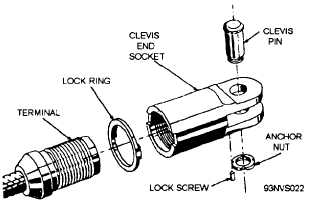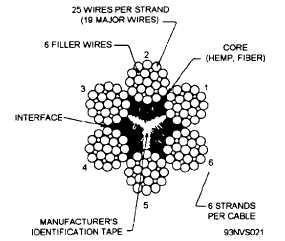As the sheave damper crosshead reaches its
BATTERY position, the battery-position indicator
limit switch is engaged, and lights the
battery-position indicator light at deck edge.
PURCHASE CABLE
The purchase cable is the wire rope reeved onto
the arresting engine sheaves and fed through
fairlead tubing and over the fairlead sheave to the
deck gear on the flight deck. The purchase cable
transmits the force of the landing aircraft from the
deck gear to the arresting engine.
The purchase cables are 1 7/16-inch diameter,
6 x 25 filler wire construction, right-hand lay, lang
lay cables with a minimum breaking strength of
195,000 pounds. The 6 x 25 filler wire construction
means that the cable is made up of 6 strands with
19 major wires and 6 filler wires per strand. (See
fig. 3-21.) The filler wires provide shape and
stability to the strand. Lang lay denotes cables in
which the wires of the strand and the strand are
twisted in the same direction so that the outer wires
in the lang lay cables run diagonally across the
longitudinal axis of the cables. The purchase cables
are made from high-strength, uncoated plow steel.
A hemp center, made from resilient oil-impregnated
hemp, serves as a foundation for the strands, keeps
the strands evenly spaced, and prevents them from
bearing against each other. The hemp center also
aids in lubrication of the inner wires. Within the
hemp center is buried a paper or plastic strip
bearing the name of the manufacturer.
Poured threaded terminals are fitted on each
end of the purchase cables. A clevis socket is
Figure 3-21 .—Cross section of preformed purchase cable.
screwed onto the threaded terminals to connect the
purchase cables to the crossdeck pendants and to
the single-reeved engines. See figure 3-22.
The Mk 7 arresting engines have an 18:1 reeve
ratio, which means for every foot of ram travel there
are 18 feet of purchase cable payout. The reeve
ratio is determined by the number of sheaves on the
crosshead.
The types of reeves used on the Mk 7 arresting
engines are 18:1 single reeve on pendant engines,
and 18:1 endless reeve on barricade engines. The
endless reeve barricade engines use only one
purchase cable with the two bitter ends terminating
on the flight deck and connected to the barricade.
The single-reeved pendant engines require two
purchase cables, one reeved around the 28-inch
pitch diameter sheaves and one reeved around the
33-inch pitch diameter sheaves of the fixed sheave
and crosshead assemblies. One end of each of the
two purchase cables is connected to a torque-release
coupling on the cable anchor damper operating
piston rod. The opposite ends are connected to the
crossdeck pendant.
DECK GEAR
The function of the deck gear is to provide a
means of engaging a landing aircraft and directing
the force of arrestment to the arresting engine. The
deck gear consists essentially of deck pendants, wire
supports,
fairlead and deck sheaves, and the
barricade system.
The deck gear is a series of
devices (used for engagement of landing aircraft)
that direct and control the energies developed
during arrestment.
Figure 3-22.—Clevis and socket assembly.
3-26




